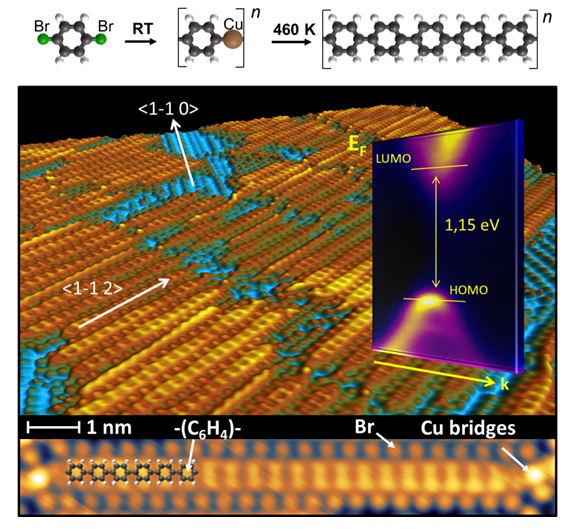A research group from the Institut Jean Lamour, in partnership with the CASSIOPEE beamline, highlighted for the first time the band-structure of a self-supported polymer, which synthesis has been perfectly controlled. Those results, published in Nature Communications (G. Vasseur et al., Nat. Commun. 7, 10235, 2016) open new possibilities for the electronics of tomorrow.
On-surface covalent self-assembly of organic molecules is a very promising bottom–up approach for producing atomically controlled nanostructures. Due to their highly tunable properties, these structures may be used as building blocks in electronic carbon-based molecular devices. The work of Guillaume Vasseur, directed by Y. Fagot-Revurat & D. Malterre (Surfaces and spectroscopies team, P2M Dpt, IJL-Nancy), reports the possibility to form, using Ullman’s catalytic reaction, an ordered array of unidimensional polymers called poly(para-phenylene) –PPP- on a Cu(110) surface. The electronic properties of those organic tracks have then been individually and locally characterized by scanning tunneling spectroscopy, highlighting the quantization of the small polymers electronic states as well as their metallization for larger PPs. The self-assembled PPP length distribution shows that most of the PPPs are longer than 8-10 nm.

Figure 1:
Top panel - polymerization reaction using Ullmann coupling applied to the dBB/Cu(110);
Middle panel - 3D topographic images showing the self-assembly of one-dimensional PPP polymers on Cu(110) surface;
Bottom panel - 2D image of a single PPP polymer and corresponding crystallographic and chemical structure;
Insert - k-resolved band-structure measured by ARPES evidencing the HOMO and LUMO molecular band, the HOMO-LUMO gap and the metallic character of the PPP polymers.
Therefore, this average length of self-assembled PPP obtained allowed for the first time to map the band structure of well-ordered polymers. Angle-resolved photoelectron spectroscopy reveals a quasi-1D valence band as well as a direct gap of 1.15 eV. In addition, the conduction band is shown to be partially filled through adsorption on the surface. Tight-binding modelling and ab initio density functional theory calculations lead to a full description of the band structure, including the gap size and charge transfer mechanisms, highlighting a strong substrate–molecule interaction that drives the system into a metallic behavior.
The growth of polymerized architectures, coupled with the control of both forbidden gap and doping is a complementary alternative to graphene nano-structures. Those molecular materials, combined with current nanotechnologies improvements, could permit to design carbon-based devices which are tunable, recyclable, and affordable and still resistant enough to constitute the elementary blocks of the electronics of tomorrow..
NB : This work has been done in collaboration with the CASSIOPEE beamline (IJL/SOLEIL association contract), INRS (Montreal, Canada) and CNR (Rome, Italy) using the France-Québec CFQCU and the France-Italy PICS-CNRS financial supports.
Here are the research partners of this work :
Institut Jean Lamour, UMR 7198, Université de Lorraine/CNRS, Vandoeuvre-les-Nancy, France,Guillaume Vasseur, Yannick Fagot-Revurat, Muriel Sicot, Bertrand Kierren, Luc Moreau, Daniel Malterre ;
Centre Énergie, Matériaux et Télécommunications, INRS, Varennes, Canada, Luis Cardenas, Gianluca Galeotti, Josh Lipton-Duffin, Federico Rosei ;
Department of Chemistry, McGill University, Montreal, Canada, Dmitrii F. Perepichka ;
Synchrotron SOLEIL, Saint-Aubin, France, Patrick Le Fèvre, François Bertran ;
Instituto di Struttura della Materia, CNR, Roma, Italy, Marco Di Giovannantonio, Giorgio Contini ;
Rensselaer Polytechnic Institute, New York, USA,Liangbo Liang, Vincent Meunier.
